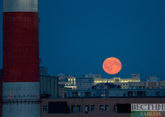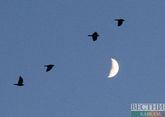On January 22, Academician, the winner of 1962 Nobel Prize for physics, the author of the fundamental Course of Theoretical Physics, the great joker and inventor Lev Landau would've turned 110.
Landau's surname became a symbol of intellectual curiosity even in the Soviet Union. Not without reason the physico-mathematical school, which is the main location in the good Soviet film 'Schedule for the Day After Tomorrow' starring Margarita Terekhova and Oleg Dahl, its plot revolves around the dispute between "physicists" and "lyricists", is named after Lev Landau, who thought that "a physicist seeks to simplify complex things, and the poet seeks to complicate simple things." In term of the Soviet education system, the film was dreamlike - students at the Landau school were treated like full-fledged creative personalities, but this is how Landau treated his students.

He was born on January 22, 1908 in Baku in the family of David Lvovich Landau, a petroleum engineer, and doctor Lyubov Veniaminovna Garkavi-Landau. During the oil boom, Landau Sr. worked as a petroleum engineer in the Black Sea and Caspian Sea Stock Company in Balakhani on the Absheron Peninsula, and later as an engineer-technologist at Azneft in Baku, published scientific works. Landau family lived in the city center at the corner of Torgovaya and Krasnovodskaya streets (Samed Vurgun and Nizami), in a large six-room apartment. In 1929, Landau's father was detained on absurd charges of illegal posession of gold coins prerevolutionary coinage, but fortunately was released soon. According to another version, the reason for the arrest was the platinum bowls that were missing in the company. Anyway, after the arrest, the parents moved from Baku to Leningrad, where Landau Jr. had already become famous by that time.
Lev Landau's scientific career was rapid. He graduated from Baku school at the age of 12, having learned to differentiate and integrate. There was nothing more he can do in school, but he was not able to attend university, being a kid. Therefore, for a year Landau attended the Baku Economical Technical School. But this fact gave birth to a famous joke about Landau depriving the Soviet Union of a capable shop manager after leaving the technical school.
It would be a mistake to think that physics was easy for Landau - he studied day and night, seeing formulas while sleeping.
He entered the Baku State University at the age of 14, studying in two departments simultaneously - he couldn't decide between the Department of Chemistry and the Departments of Physics and Mathematics. A year later, the 16-year-old genius transferred to the Physics Department of Leningrad State University. Nevertheless, Landau remained interested in the field throughout his life.

After graduating, he began working at the Leningrad Physico-Technical Institute and at the age of 19 made a fundamental contribution to quantum theory. It is difficult for an average person to understand Landau's first work, as well as his other achievements, so we will not go into the density matrix method in quantum mechanics. But it was a breakthrough for the scientific world and the People's Commissariat for Education sent a young scientist to Europe for training. He was fluent in German and French since childhood.
Landau met Albert Einstein at Berlin University; attended seminars of one of the creators of quantum mechanics Max Born in Göttingen; met with Werner Karl Heisenberg in Leipzig, who proclaimed the 20th century a century of quantum mechanics and soon was awarded the Nobel Prize in Physics; he worked with Niels Bohr in Copenhagen, after which Landau always considered himself his pupil; in England he met with Peter Kapitza, who worked in the Cavendish Laboratory in Cambridge with Ernest Rutherford.
Later, Landau told his friends about the state of ecstasy to which he was brought on reading the articles by Heisenberg and Schrodinger signalling the birth of the new quantum mechanics. He said that he derived from them not only delight in the true glamour of science but also an acute realization of the power of the human genius, whose greatest triumph is that man is capable of understanding things beyond the pale of his imagination.
The People's Commissar sent Landau abroad for only six months, but he managed to stay in Europe for much longer, thanks to a Rockefeller Foundation fellowship, arranged for the Soviet physicist by Niels Bohr. This gave Landau a chance to finish works on the diamagnetism of a free electron gas and relativistic quantum mechanics.

After returning to the Soviet Union, Landau headed the Department of Theoretical Physics at the National Scientific Center Kharkiv Institute of Physics and Technology, and at the age of 29 became the head of the Theoretical Division at the Institute for Physical Problems on the recommendation of Peter Kapitza. But the departure from Kharkov was due not only to scientific considerations - in those years the staff of the Kharkov Institute was affected by Stalinist terror, several scientists were arrested and shot. The threat of Landau's arrest was quite real, because he had worked abroad for several years and could be recruited by "enemies of the Soviet power".
At the same time, Landau owes much of his achievements to Kharkov- there he published works on sound dispersion, the energy source of stars, scattering of light, collisional energy transfer, superconductivity, the magnetic properties of various materials, and finally, in Kharkov, he met His Kora, his future wife Koncordia Drobantseva. Since 1934 they lived in a civil marriage and got married only in the summer of 1946, just before the birth of their son.

Landau considered marriage a cooperative, not related to love, and therefore concluded a "marriage non-aggression pact" with Kora, which gave them freedom to have a bit on the side.

Departure from the Ukrainian capital did not help to avoid an arrest. The 30-year-old Landau spent a year in prison, despite letters to Stalin and Beria sent by Peter Kapitza and Niels Bohr, who asked to release the physicist to enable him to continue the research work important for the progress of mankind. Eventually, Landau was released, but was permanently deprived of the opportunity to communicate with foreign colleagues and go abroad, having established supervision over him.

After the war, Landau was reluctant to participate in the Soviet atomic project, and only when Stalin died, the physicist managed to leave the anti-human project.
Landau received the 1962 Nobel Prize in Physics for his development of a mathematical theory of superfluidity that accounts for the properties of liquid helium II at a temperature below 2.17 K, but he received a prize in the hospital ...
As a man of a living mind, Landau had a hard time during long car trips and came up with a game of numbers. At that time, the machine numbers consisted of two letters and two pairs of numbers. Landau was looking for mathematical actions that would make it possible to equate both pairs of numbers. To do this, you need to choose and insert in each pair of digits suitable operational signs and elementary function symbols: +, -,:, x, √, log, lg, sin, cos, tg, ctg, sec, cosec, factorial.
When Landau saw a car with 71 and 15 in its number, he immediately had a solution: 7√1 = 15.
He equated 53 and 41 with the help of the factorial: - (5-3!) = √4-1. He made the equation 7-5 = log√33 out of 75 and 33. But there were numbers that did not succumb to Landau's mathematical genius: 59 and 58; 47 and 73; 47 and 97 ....
Perhaps on January 7, 1962, Landau played his favorite game while being on his way from Moscow to Dubna on the Dmitrov Highway, maybe he thought about the prospects of Soviet science, maybe about something else ... but the car crash was terrible. As a result of numerous fractures, hemorrhage and head trauma, Landau spent two months in a coma. His life was saved by physicists who sent the latest medicines from around the world. Landau recover from the coma, but never returned to scientific work. He died on April 1, 1968 at the age of 60. So this year marks not only the jubilee date - 110 years from his birth, but also a round memorable date - half a century after the death of the author of scientific theories and the theory of happiness. According to the latter, each person must be happy, using the formula of the three components - work, love and communication with people.
Landau had it all. And he classified all of it wittily. According to Landau's classification, there are pretty, beautiful and interesting girls. To take advantage of Landau's "unscientific conclusions", one should look at a lady's nose - pretty ones have ab upturned nose, beautiful ones - straight, interesting ones - rather big. His classification of sciences can be considered another "unscientific", but quite relevant and applied research. According to Landau, they are divided into natural, unnatural and preternatural.












